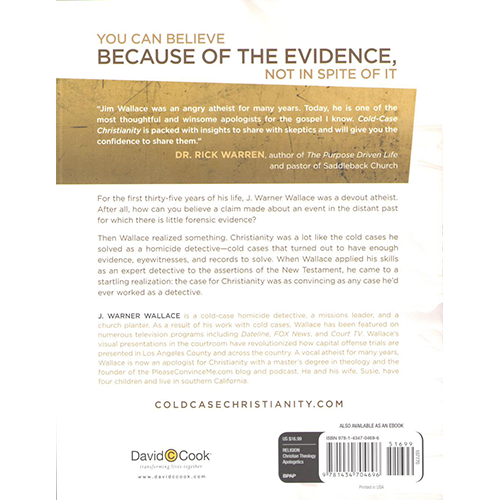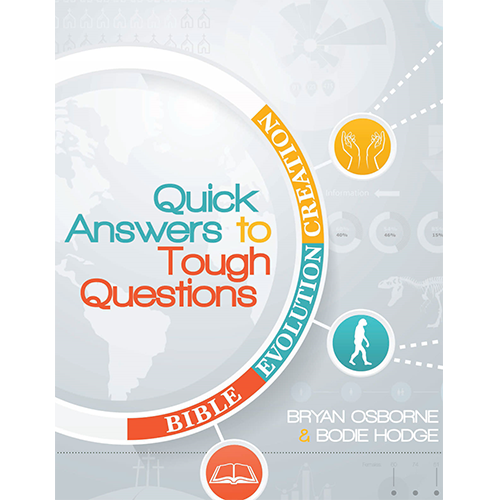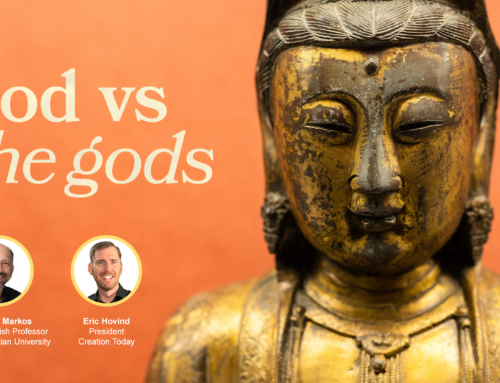If you’ve spent any time listening to the criticisms of Christianity from skeptics, you very quickly hear the assertion that there are contradictions in the Bible. Not only are you told that the Bible contradicts itself (thus, they assure you, destroying the claim that it is the word of God) but you will be told that it contradicts itself HUNDREDS OF TIMES! Ask any skeptic and they will echo this claim with great confidence. However, when you ask them to show you an example, they very often will say something like, “There are SO MANY. I don’t even know where to begin!” And they will not be able to show you a single one. Without their help, you are left to dig into the scriptures yourself to find those HUNDREDS of alleged contradictions.
If you’re like a lot of Christians, you’ve probably read the Bible for many years without seeing ANY of these alleged contradictions. Even after you’ve been told with great bravado by your atheist friends that there are HUNDREDS of them, you may still read the Bible and not see a single one! So what’s a Christian to do? Is it possible that these skeptics can ALL be wrong? Can we really deny the confidence and bravado with which this claim is provided merely because they fail to provide any legitimate examples? Worry not friends, for with a little guidance and understanding of the rules of literary criticism, you will understand exactly what these well meaning friends on social media are talking about. With a little help, you will be able to find examples of contradictions in the Bible EXACTLY like these many internet skeptics do. It’s easy!
(Author’s Note: Before you send us an email letting us know that we are heretics, please do read to the end.)
What is a Contradiction?
Before you can look for contradictions, you have to know what a contradiction is.
Very simply a contradiction is when two assertions of fact cannot both be true.
For example, imagine a novel where world famous Belgian detective, Hercule Poirot asks a man where he was when a particular woman entered a particular room, and he replies;
“When she entered the room, I was sitting on the couch.”
But when asked again, the same man replies;
“When she entered the room, I was standing by the fireplace.”
And then in chapter 16 Poirot discovers the man’s private journal where his account of that moment is the following;
“When she entered the room, I was engaging the landing gear on my Moon Lander spacecraft.”
If all three of these were accounts of what that man was doing “when she entered the room,” it should be clear that they CANNOT all be true. He could not have been sitting in the room, standing in the room, and landing on the moon all at the same moment. At least two of these MUST be false. If multiple accounts CANNOT all be true, then there is a contradiction.
But it’s a little more complicated than this. There are some rules one must follow in order to distinguish between an actual contradiction and what is merely an apparent contradiction.
RULE #1: CONTEXT makes all the difference.  Context is the information surrounding a statement of fact. It’s who made the statement, when they said it, who they said it to, and other facts like that. It’s the information which fills in what a particular statement does not say, which may come from other places.
Context is the information surrounding a statement of fact. It’s who made the statement, when they said it, who they said it to, and other facts like that. It’s the information which fills in what a particular statement does not say, which may come from other places.
For example, if the man tells world famous Belgian detective, Hercule Poirot “When she entered the room, I was sitting on the couch,” and later tells him “When she entered the room, I was standing by the fireplace,” these may be contradictory depending on the context. If the word “SHE” in both statements refer to the same woman, and the entering the room was the SAME entering the room, then it is a contradiction. However, if the first “SHE” is his wife, Beatrice, and the SECOND “SHE” is his great aunt Edna, both statements can be true because they are describing two different events. Or perhaps if “SHE” is his wife in both instances, but he is describing two different instances of her entering a room, then again they could both be true. Once the context is filled in, what looks like a contradiction is revealed to be two separate facts that are not in conflict.
RULE #2: The context of a Bible verse is necessary to understand it properly.
Any single verse of the Bible belongs to a chapter, which is found in a book of the Bible. Those books are written by specific men at specific times. Much of the Bible includes historical accounts of people saying things, and sometimes those people are telling stories or recounting what other people have said. Once again, the context is vital to a proper understanding.
For instance, in Mark chapter 12, these words are spoken by Jesus: “This is the heir; come, let us kill him, and the inheritance will be ours.”
At first glance, you might think that Jesus is up to something nefarious! But the larger context of the chapter tells you that Jesus is telling a story, and one of the characters in the story says this. While these words literally come out of Jesus’ mouth, he is not speaking on his own behalf, but is telling his listeners what the person in the story said.
So don’t worry. Jesus is still the good guy. But this example shows the importance of the next rule:
RULE #3: Never read “a” Bible verse.
Always read a verse in its context. If you are to understand what any verse means, you need to know the bigger context. There are a lot of places where taking a Bible verse out of context will leave the reader without enough information to understand what is going on and what is being said. The Bible isn’t a bullet pointed list of pithy statements. It’s largely a book of history, which means every story is part of an even bigger story which is needed to fill in all of the context.
For example, In John 18 we read, “When he had finished praying, Jesus left with his disciples and crossed the Kidron Valley.” If this verse was the only thing you read, then you would logically assume that Jesus left with all twelve of his disciples and crossed the Kidron Valley, but you would be mistaken. While this one verse says “with his disciples” it doesn’t include all twelve because in chapter 13, Judas had left them to go betray Jesus to his enemies. If you don’t know the context of chapter 13, then the assumption you make at the start of chapter 18 would be reasonable, but it would be wrong. Sometimes you get context from other books in the Bible. In Chapter 18, instead of saying, “Then Jesus left with his eleven remaining disciples, as Judas had left them back in chapter 13,” John simply refers to the remaining eleven as “his disciples” and assumes that you have read chapter 13 already, and that you can subtract one from twelve and arrive at the correct number.
RULE #4: A Contradiction must be based on what IS said in the text.
If you are to discover a contradiction in the Bible, or in any account, it must be based on what IS SAID, not on what we must infer from what is NOT said.
For example, the man tells world famous Belgian detective, Hercule Poirot “When she entered the room, I was sitting on the couch.” But suppose in a later chapter the same character tells Poirot “I didn’t actually see her enter the room. I wasn’t in the room at the time.” Is this a contradiction? Is this man a DIRTY LIAR?!?
Not necessarily.
From his first statement, we may infer rather logically that he was sitting on the couch in the room that she entered, BUT HE DOES NOT SAY SO. He leaves out the detail of WHERE “the couch” is located, and we fill in that gap ourselves, probably without realizing it.
If she entered the LIVING ROOM, it’s possible that he was sitting on the couch in the DRAWING ROOM (which is a room people in Agatha Christie’s books have, even though they don’t tend to do enough drawing to demand an entire room dedicated to it). His statements would both be correct, even though it contradicts our reasonable assumptions. What SEEMED like a contradiction in his story is not an actual contradiction. The conflict is not between his two statements, but between the assumptions WE used to fill in the gaps of what he did NOT say in the first statement, and the details he added in the next statement.
Similarly, the Bible only contains so many pages, and sometimes the authors leave out details that we wish we knew. Sometimes we have to take an educated guess to fill in what they did not say, just as we do in ANY historical account. But if our educated guess contradicts what some passage ACTUALLY SAYS, this is NOT a valid contradiction. This is not an example of the Bible contradicting the Bible. This is an example of the Bible contradicting something we have guessed based on what we don’t know.
That’s not the same thing.
RULE #5: Bible passages need to be understood according to their literary genre.
Not all passages in the Bible are written in the same voice. Some of the Bible is historical narrative, simply recording what happened at a specific place and time. Other verses are literally song lyrics which are meant to be sung. Some of it are the words of God spoken to his prophets, and some are teachings from the people of God without the words of God. A handful of passages tell us things Satan did and said.
The Genre of any passage is part of its context. Pretending that a historical narrative is just an allegorical parable is just as likely to run into error as pretending that symbolic poetry is literal historical narrative. This is probably how many cults get started. To understand a passage correctly, you need to ask how the author intended it to be read.
Rule #6: The whole Bible is the Word of God, but not all of the Bible are the WORDS of God.
Like I said above, sometimes the narrative in the Bible includes God communicating with his people. “Thus sayeth the LORD…” However, this does not mean that the whole Bible somehow represents God’s teachings and commands. The Bible is not simply the transcript of a lecture given by Jesus to his disciples. The Bible contains a lot of people saying and doing a lot of things, and much of what they do is bad. In fact, the reason why a lot of it is included is to show sinners sinning. VERY little of the Bible includes the idea, let alone the command to “go and do likewise.”
The fact that God commands us NOT to murder, and then the Bible tells us stories of people committing murder is NOT a contradiction. It’s just an example of why God needed to write down some commandments.
Also, sinners sin. Much of history is the account of people doing bad things, and then the events which result. When the Bible records such history, God does not break into the narrative every time to say, “You see what this guy just did? That was naughty. Don’t do that.” Often we’re just told what people did. Sometimes condemnation follows quickly in the story, like when King David had an affair and then killed a guy to cover it up. A prophet showed up soon after to tell him to his face that he had sinned.
Sometimes people just suffer for their bad choices, like most of the story of Sampson.
Sometimes we are given a list of commandments written on stone by the finger of God.
Not every event in the Bible carries the same explicit moral lessons. Just remember that DESCRIPTION is not PRESCRIPTION. Just because the Bible describes something without condemning it doesn’t mean it is affirming it.
Making Use of these Helpful Rules
These six rules for reading the Bible are very helpful for a great many things. They can help us come to a deeper understanding of what the Bible intends to teach us. We can develop a better understanding of the stories depicted and see how they fit into the overall historical story from Creation to today, as well as the way these stories all fit into the overarching theological story of the fall and redemption. These rules can help us find a deeper understanding of what the Gospel is.
How can these rules help us find those hundreds of contradictions in the Bible? How do we use these rules to see what our atheist and skeptic friends are seeing? It’s very simple. Take all six of these rules described above, and ignore them COMPLETELY. Soon you will be finding contradictions in the Bible, just like our skeptic friends on social media!
It really is that easy.













